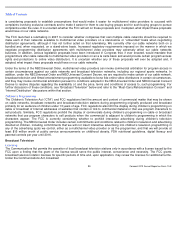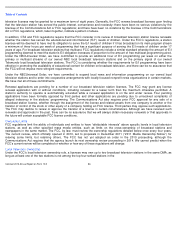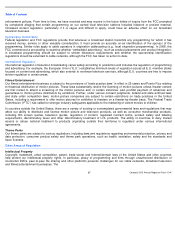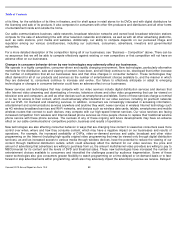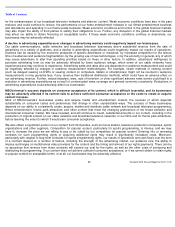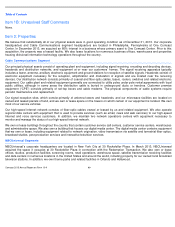Comcast 2013 Annual Report Download - page 38
Download and view the complete annual report
Please find page 38 of the 2013 Comcast annual report below. You can navigate through the pages in the report by either clicking on the pages listed below, or by using the keyword search tool below to find specific information within the annual report.
Table of Contents
viewing and advertising skipping have become more common as the penetration of DVRs has increased and as content has
become increasingly available via video-on-
demand services and Internet sources. Some of these new technologies are also
challenging the existing legal copyright framework that we rely on to protect and monetize our intellectual property rights, as more
fully discussed below in “
Our businesses depend on using and protecting certain intellectual property rights and on not infringing
the intellectual property rights of others.”
These and other changes in technology, distribution platforms and consumer behavior
could have an adverse effect on our businesses.
Our businesses depend on keeping pace with technological developments.
Our success is, to a large extent, dependent on our ability to acquire, develop, adopt and leverage new and existing technologies,
and our competitors’
use of certain types of technology and equipment may provide them with a competitive advantage. For
example, some companies are building costly fiber-optic networks that provide significant high-
speed Internet access speeds and
wireless Internet technologies continue to evolve rapidly. We expect other advances in communications technology to occur in the
future. If we choose technology or equipment that is not as effective or attractive to consumers as that employed by our
competitors, if we fail to employ technologies desired by consumers before our competitors do so, or if we fail to execute effectively
on our technology initiatives, our business and results of operations could be adversely affected. Moreover, we may incur additional
costs as we execute our technology initiatives, such as the deployment of our X1 platform and wireless gateways. We also may
incur increased costs if changes in the products and services that our competitors offer require that we offer certain of our existing
services or enhancements at a lower or no cost to our customers or that we make additional research and development
expenditures, which could have an adverse effect on our businesses.
Programming expenses for our video services are increasing, which could adversely affect our businesses.
We expect programming expenses for our video services to continue to be our Cable Communications segment’
s largest single
expense item and to increase in the foreseeable future. The multichannel video provider industry has continued to experience an
increase in the cost of programming, especially sports programming. In addition, as we add programming to our video services or
distribute existing programming to more of our customers and through additional delivery platforms, we incur increased
programming expenses. Additionally, we are currently paying certain local broadcast television stations in exchange for their
required consent for the retransmission of broadcast network programming to our video services customers and expect to continue
to be subject to increasing demands for payment and other concessions from local broadcast television stations. If we are unable to
raise our customers’
rates or offset such programming cost increases through the sale of additional services, the increasing cost of
programming could have an adverse impact on our results of operations. Moreover, as our contracts with content providers expire,
there can be no assurance that they will be renewed on acceptable terms or that they will be renewed at all, in which case we may
be unable to provide such content as part of our video services and our businesses could be adversely affected.
We are subject to regulation by federal, state, local and foreign authorities, which may impose additional costs and
restrictions on our businesses.
Federal, state and local governments extensively regulate the video services industry and may increase the regulation of the
Internet service and VoIP voice service industries. We expect that legislative enactments, court actions and regulatory proceedings
will continue to clarify, and in some cases may adversely affect, the rights and obligations of cable operators and other entities
under the Communications Act and other laws. Our broadcast television business also is highly regulated by federal laws and
regulations, and our cable networks, filmed entertainment and theme parks businesses are subject to various other laws and
regulations at the international, federal, state and local levels, including laws and regulations relating to environmental protection,
which have become more stringent over time, and the safety of consumer products and theme
33
Comcast 2013 Annual Report on Form 10
-
K


